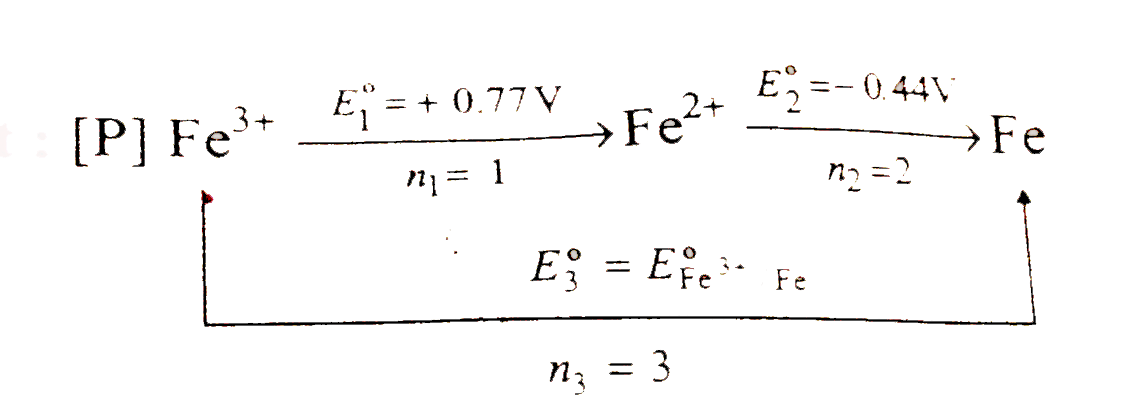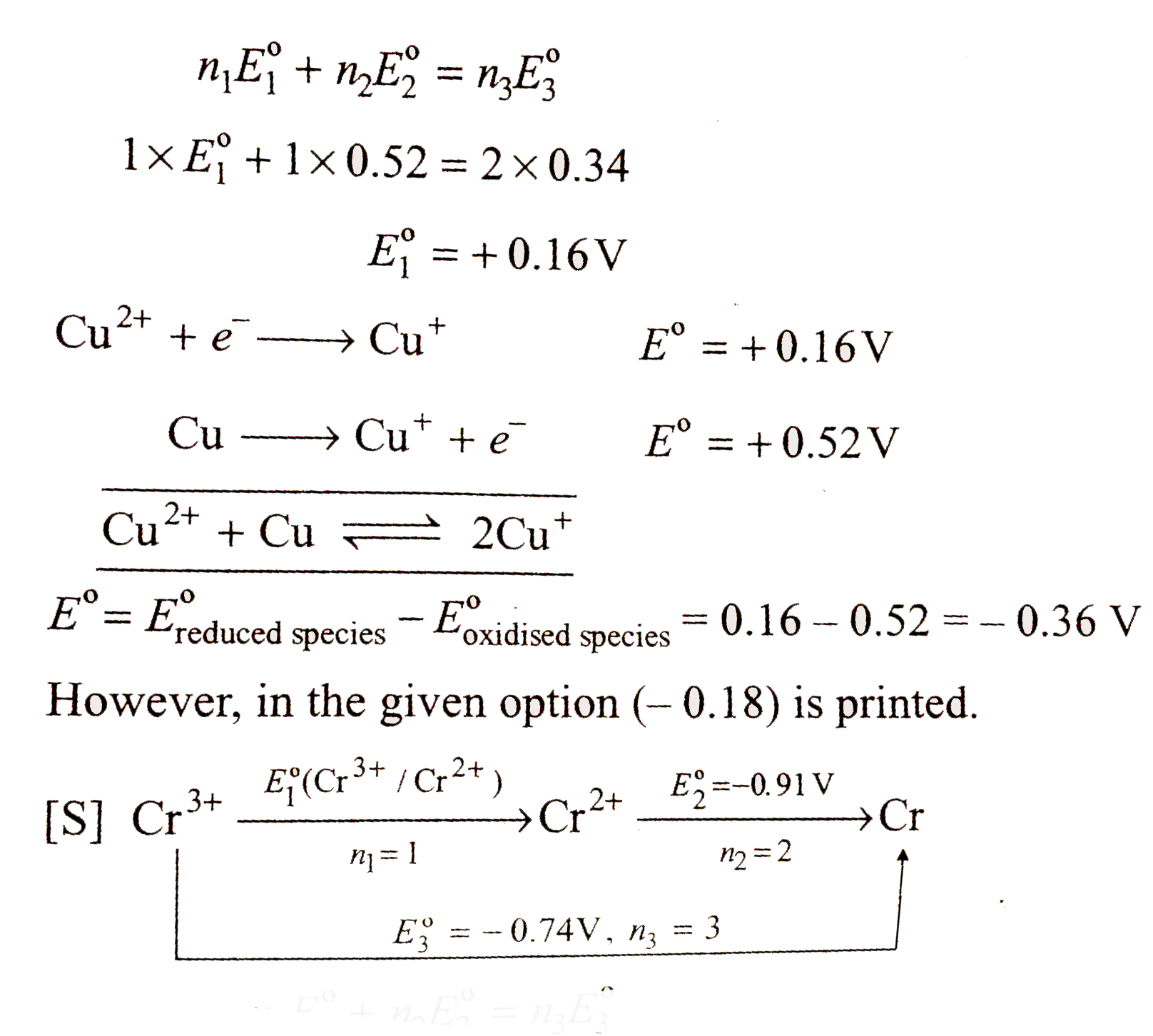The standard reduction potential data at 25∘C is given below
E∘(Fe3+,Fe2+)=+0.77V,
E∘(Fe2+,Fe)=−0.44V,
E∘(Cu2+,Cu)=+0.34V,
E∘(Cu+,Cu)=+0.52V,
E∘(O2(g)+4H++4e−→2H2O]=+1.23V
E∘[(O2(g)+2H2O+4e−→4OH−)]=+0.40V,
E∘(Cr3+,Cr)=−0.74V,
E∘(Cr2+,Cr)=−0.91V,
Match E∘ of the redox pair in List-I with the values given in List-II and select the correct answer using the code given below teh lists:
List−IList−II(P)E∘(Fe3+,Fe)(1)−0.18V(Q)E∘(4H2O⇔4H++4OH+)(2)−0.4V(R)E∘(Cu2++Cu→2Cu+)(3)−0.04V(S)E∘(Cr3+,Cr2+)(4)−0.83V
Codes:
P = 4, Q = 1, R = 2, S = 3
P = 2, Q = 3, R = 4, S = 1
P = 1, Q = 2, R = 3, S = 4
P = 3, Q = 4, R = 1, S = 2
The correct Answer is:D

n1E∘1+n2E∘2=n3E∘3
1×0.77+2(−0.44)=3×E∘3
E∘3=−0.113≈−0.04V
[Q]2H2O→O2+4H++4e−E∘=−1.23VO2+2H2O+4e−→4OH−E∘=+0.40V¯¯¯¯¯¯¯¯¯¯¯¯¯¯¯¯¯¯¯¯¯¯¯¯¯¯¯¯¯¯¯¯¯¯¯¯¯¯¯¯¯4H2O⇔4H++4OH−–––––––––––––––––––––––––––

n1E∘1+n2E∘2=n3E∘3
1×E∘1+1×0.52=2×0.34
E∘1=+0.16V
Cu2++e−→Cu+E∘=+0.16VCu→Cu++e−E∘=+0.52V¯¯¯¯¯¯¯¯¯¯¯¯¯¯¯¯¯¯¯¯¯¯¯¯¯¯¯¯¯¯¯¯¯¯¯¯Cu2++Cu⇔2Cu+––––––––––––––––––––––––
E∘=E∘reduced species−E∘oxidised species=0.16−0.52=−0.36V
However, in the given option (−0.18) is printed.

n1E∘1+n2E∘2=n3E∘3
1×E∘1+2(−0.91)=3×(−0.74)
E∘1=−0.4V
Topper's Solved these Questions
- BOOK - OP TANDONCHAPTER - ELECTROCHEMISTRYEXERCISE - Integer Type Question16videos
ELECTROCHEMISTRY
- BOOK - OP TANDONCHAPTER - ELECTROCHEMISTRYEXERCISE - LINKED COMPREHENSION TYPE QUESTION40videos
ELECTROCHEMISTRY
- BOOK - OP TANDONCHAPTER - ELECTROCHEMISTRYEXERCISE - Assertion- Reason27videos
ELECTROCHEMISTRY
- BOOK - OP TANDONCHAPTER - COORDINATION COMPOUNDSEXERCISE - SBJECTIVE TYPE96videos
COORDINATION COMPOUNDS
- BOOK - OP TANDONCHAPTER - HALOALKANES AND HALOARENES EXERCISE - Single Interger answer type questions14videos
HALOALKANES AND HALOARENES
Similar Questions
Knowledge Check
- Question 1 - Select One
The standard reduction potential data at 25∘C is given below
E∘(Fe3+,Fe2+)=+0.77V,
E∘(Fe2+,Fe)=−0.44V,
E∘(Cu2+,Cu)=+0.34V,
E∘(Cu+,Cu)=+0.52V,
E∘(O2(g)+4H++4e−→2H2O]=+1.23V
E∘[(O2(g)+2H2O+4e−→4OH−)]=+0.40V,
E∘(Cr3+,Cr)=−0.74V,
E∘(Cr2+,Cr)=−0.91V,
Match E∘ of the redox pair in List-I with the values given in List-II and select the correct answer using the code given below teh lists:
List−IList−II(P)E∘(Fe3+,Fe)(1)−0.18V(Q)E∘(4H2O⇔4H++4OH+)(2)−0.4V(R)E∘(Cu2++Cu→2Cu+)(3)−0.04V(S)E∘(Cr3+,Cr2+)(4)−0.83V
Codes:APQRSA4123BPQRSB2341CPQRSC1234DPQRSD3412 - Question 2 - Select One
E∘ of Fe2+/Fe=−0.44V,E∘ of Cu/Cu2+=−0.34V .
Then in the cellACu2+ Oxidizes FeBFe2+ oxidizes CuCCu Reduces Fe2+DFe reduces Cu2+ - Question 3 - Select One
E∘Cu2+/Cu=0.34V
E∘Cu+/Cu=0.522V
E∘Cu2+/Cu+=A0.158B-0.158C1.182D-0.182
What is the standard reducing potential (E∘) for Fe3+→Fe?
(Given that Fe2++2e−→Fe, EFe2+/Fe∘=−0.47V
Fe3++e−→Fe2+, E∘Fe3+/Fe2+=+0.77VView SolutionCopper from copper sulphate solution can be displacesd by. (The standard reduction potentials of some electrodes are given below):
Eo(Fe2+/Fe)=−0.44V,Eo(Zn2+/Zn)=−0.76V
Eo(Cu2+/Cu)=+0.34V:Eo(Cr3+/Cr)=−0.74V
Eo(H+0H2)=0.00VView SolutionWhat is the standard reduction potential (E∘) for Fe3+→Fe?
Given that :
Fe2++2e−→Fe,E∘Fe2+/Fe=-0.47V
Fe3++e−→Fe2+,E∘Fe3+/Fe2+=+0.77VView SolutionCopper from copper sulphate solution can be displaced by …………. The standard reducation potentials of some electrodes are given below:
(a) E∘(Fe2+,Fe)=−0.44V
(b) E∘(Zn2+,Zn)=−0.76V
(c) E∘(Cu2+,Cu)=+0.34V
(d) E∘(H+,1/2H2)=+0.34VView SolutionWhat is the standard reducing potential (E∘) for Fe3+→Fe?
(Given that Fe2++2e−→Fe, EFe2+/Fe∘=−0.47V
Fe3++e−→Fe2+, E∘Fe3+/Fe2+=+0.77VView Solution

